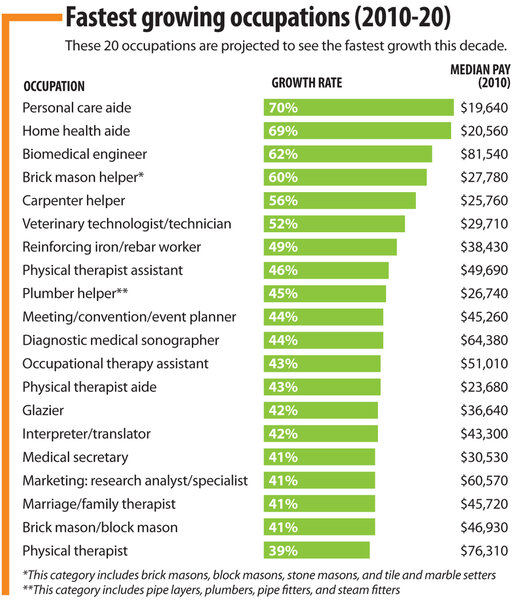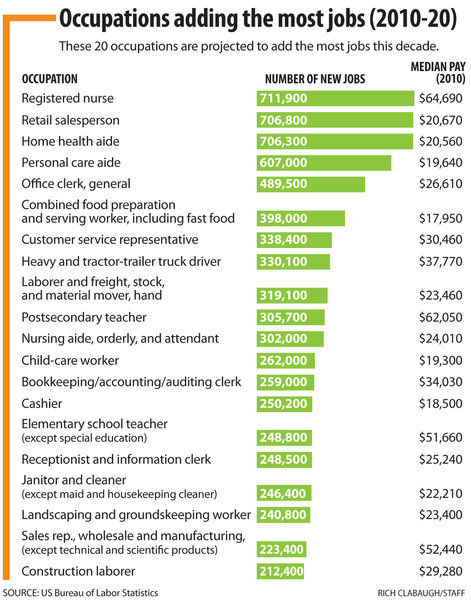10 surprises about tomorrow's job market
Loading...
| Boston
The mustachioed patient is surprisingly vibrant – for a dummy. He moves. He complains that he wants something to drink. The nurses confer, raise him to a sitting position, and then consult with a "doctor" by phone.
Hour after hour, groups of four student nurses at Boston's Northeastern University go through a training session at the school's mock emergency room. After four to five years of schooling, they'll venture out into a job market that will be as attentive to them as they are to their smocked "patient." The US economy is expected to add more registered nurses (RNs) from 2010 to 2020 than workers in any other job occupation, according to projections from the Bureau of Labor Statistics (BLS).
"I have a few friends who recently graduated and got jobs right away," says Carly Small, a sophomore nursing student.
Across the Charles River at the Red Cross in Cambridge, Mass., class is also in session. The students are learning basic tasks on their way to becoming home health aides: from the proper way to wash hands to how to move people from lying on their backs to their sides. The job market embraces them enthusiastically, too. Home health aides represent the second-fastest growing occupation, the BLS projects.
"I decided to start this for a better future for my kids," says Evelyn Perez, a single mom with three kids.
The two training sessions going on a few cobblestoned blocks apart in the Boston area highlight an unusual dimension of tomorrow's job market: Demand for workers should be strong on both ends of the skill spectrum. It's those in the middle who may want to look at their résumés.
While the students at Northeastern will take four to five years to complete their nurses' training, the home health aide students will complete their training in four weeks. The RNs can expect much better pay: Their median salary was $64,690 in 2010. Home health aides made only $20,560, which is below poverty level for a household of four.
Yet people pursuing both career paths will likely find jobs, which is indicative of a far broader trend in America. While employment growth is sluggish right now – the unemployment rate ticked up in January to 7.9 percent, according to the BLS, with the economy creating only 157,000 net new jobs – it's expected to pick up later this decade. Most of that growth will occur at the top and the bottom of the earnings scale. Among the top 20 fastest-growing professions from 2010 to 2020, according to the BLS, will be high-skill jobs like biomedical engineers, college professors, and veterinarians (see chart, page 30). But the list will also include many low-skill occupations, like helpers for carpenters, plumbers, and brick masons; glaziers; and cashiers.
Part of this is a fluke of the business cycle. Because of the Great Recession, which walloped the construction industry, jobs in various building trades will have to surge just to get back to normal levels of employment. But there's more involved in the process than that.
The main reason the low and high ends of the job market are growing is that the middle is getting squeezed. Different explanations are put forward for this: government policy, the decline of unions, offshoring jobs. But the prevailing theory is that middle-skill positions are disappearing because of technology.
The process has been going on for 30 years, but it has been largely obscured because it happens in fits and starts. The theory, as propounded by David Autor, an economist at the Massachusetts Institute of Technology (MIT) in Cambridge, is that the rapid spread of low-cost computing power has replaced many "routine" jobs. These workers accomplish a set of specific activities by following defined procedures, which a computerized device can mimic. Think automated teller machines instead of bank tellers, robots instead of factory workers, computerized answering systems instead of customer service representatives.
But computers aren't good at handling nonroutine jobs, whether it's managing a work group or cleaning up a mess in an elementary school. So they don't eliminate jobs at the top end of the skill spectrum, such as research scientists and managers. They also don't replace low-skill nonroutine occupations, like janitors.
"This process is going to gain more and more steam," says Nir Jaimovich, an economist at Duke University in Durham, N.C. His research shows that almost all the loss of these routine jobs happens during recessions – and they never come back during the recovery. So the Great Recession has hit the reset button on these occupations. In 1981, routine positions accounted for 58 percent of all jobs; by 2011, they were down to 44 percent.
Yet other surprises await future job hunters as well. As the nation struggles to crawl out of recession, here are 10 things you may want to know as part of an unofficial guide to tomorrow's job market:
1. Some booms really are booms.
The US oil and gas industry is likely to continue to be a source of jobs – and flush paychecks – for the foreseeable future.
Deployment of hydraulic fracturing or "fracking" technology in places like North Dakota, Pennsylvania, and Texas has reversed the nation's long decline in oil and gas production. Fluctuating energy prices could take the bloom off the drill bit at some point. Some places, like Towanda, Pa., have already seen many drillers move on to more valuable gas fields, leaving empty cafe booths in their wake.
But overall, experts believe the boom will continue for many years despite the vicissitudes of the global energy market and environmental concerns about fracking.
By 2020, development of so-called unconventional sources of petroleum should yield 4.5 million barrels per day, more than twice today's output, forecasts IHS Global Insight. That translates into a hiring of nearly 1.3 million workers over that time, the consulting firm estimates.
If those numbers aren't impressive enough, consider this: Hilcorp Energy Company, a Houston-based oil and gas producer, made the 2013 list of Fortune magazine's top companies to work for. One reason: The firm is planning to give every employee a $100,000 bonus if it doubles its production rate and reserves by 2015.
2. Other booms are more of a mirage.
The nation is seeing a decided rebound in manufacturing after the Great Recession. As Chinese wages go up, American companies are beginning to bring back some of the production they outsourced to Asia, particularly for higher-margin products, such as sophisticated appliances and speciality athletic shoes.
Between 2008 and 2018, output of the nation's factories should jump nearly 23 percent to $4.9 trillion, a huge change given that manufacturing is the nation's largest industry by output, according to a study by the Center on Education and the Workforce at Georgetown University.
Yet despite the surge on the nation's factory floors, manufacturing employment is expected to shrink from 13.6 million jobs in 2008 to 13 million by 2018, the center forecasts.
"Post-recession growth in that sector will result from greater productivity, not from expansion of the workforce," it says.
3. When in doubt, specialize.
The health-care industry is forecast to be a huge driver of employment this decade, because of an expected growth in demand from health reform and from an aging population. Whether you're looking for a job inside or outside the industry, the trick is to specialize.
By 2020, the economy is projected to need more than 30 percent more optometrists, veterinarians, and database administrators. It will need some 40 percent more marriage and family therapists, interpreters and translators, and meeting and event coordinators.
For something a little more offbeat, you can try nonfarm animal caretaker (up 27.8 percent); athlete, coach, or umpire (up 28.3 percent); or geographer (up 35.4 percent).
4. Green isn't always gold.
In 2008, in the run-up to the presidential election, a study released by the United States Conference of Mayors estimated the US had about 750,000 "green" jobs. Over the next 30 years, it forecast the green sector would account for as much as 10 percent of employment growth, adding 4.2 million jobs.
Those numbers were probably too optimistic: Don't count on a career making wind turbines just yet.
Actually, one of the projections the mayors produced turned out to be far too conservative. Last year, the BLS estimated green jobs for the first time, finding that they numbered 3.1 million, or 2.4 percent of full-time workers. But most of these jobs have been around for a long time. Mark Muro, a senior fellow at the Brookings Institution in Washington, calculates that only 100,000 new green jobs were created between 2003 and 2010.
Nor are some of the positive things that happened to the green movement last year – a 20-year low in carbon dioxide emissions, plummeting costs to consumers for solar power, and a record year for the wind industry – evidence that green jobs will surge in the future.
Emissions are down mostly because utilities are replacing coal-fired plants with cheaper and cleaner natural gas plants. Solar panels are inexpensive because Chinese manufacturers have flooded the market and driven some US firms out of business. Indeed, the administration has slapped tariffs of between 24 and 36 percent on Chinese panels. And the main reason that the wind industry had a good year is that installers were rushing to finish projects before the potential end of a federal subsidy.
With natural gas so abundant, the push to move to green alternatives looks as if it will be delayed.
5. Welcome to the era of the 'hybrid worker.'
Americans in recent decades have been changing careers with increasing regularity. In the future, many of them will be carving out personalized niche jobs by combining the skills they used in previous work experiences. Gina Vita is one such "hybrid worker."
She started out as an X-ray technician, moved on to cardiac research, and then dropped out of the labor force to raise her children. Twelve years later, she wanted to work again.
Friends began to ask Ms. Vita, who is a fitness buff, to help them with their workouts. So she got her certification from the American College of Sports Medicine and became a personal trainer. "I have that background work in the hospital," she says, which allows her to help clients avoid injury.
She would have made more money resuming a career as an X-ray technician. But "it was a gerbil wheel," she says. "I started out seeing people who are ill. Now, I'm preventing people from getting ill."
Hybrid workers are more common today because the recession delayed career-switching.
"There's a tremendous amount of pent-up demand to change careers," says Jim John, chief operating officer of Beyond.com, a career network based in King of Prussia, Pa. "I'm looking at résumés from people who went to law school and are looking to get into marketing."
But these workers have been at their current job long enough that starting over would now mean a steep pay cut in many cases. So workers are trying to bridge their careers. One friend who was a physician decided to go back to law school and now serves as a legal consultant on health-care issues, Mr. John says.
6. The death of a salesman hasn't happened.
The Internet Age was supposed to make salespeople obsolete. Instead, retail sales is expected to add more jobs than any profession except nursing between 2010 and 2020. Wholesale and manufacturing sales representatives (not involved in scientific or technical products) are No. 19 on the same BLS list.
And those numbers may underestimate the importance of the profession today: Many sales reps are moving from working for corporations to becoming employees to independent contractors.
"All those death notices for sales and those who do it are off the mark," writes Daniel Pink, author of "To Sell Is Human." "Indeed, if one were to write anything about selling in the second decade of the twenty-first century, it ought to be a birth announcement." In 2010, even after the worst downturn since the Great Depression, the share of Americans working in sales is the same as it was in 2000, he calculates: 1 in 9.
7. Meet your new digital staff.
Those online networks known as social media are being used for doing more important things than simply chatting with friends. Increasingly, they're allowing workers to develop sophisticated networks of contacts who can help them carry out their jobs.
Peter Schwartz calls it being "hyperconnected." By using increasingly powerful online tools, most workers will be able to replicate having a handful of assistants who gather research, prepare for meetings, and keep their schedule. It's like having an invisible support staff, allowing people to work smarter in a Knowledge Economy.
It will result in an "enriched, empowered, highly capable, autonomous decision worker [with] more freedom, more demands, but more options," says Mr. Schwartz, senior vice president for global government relations and strategic planning for Salesforce.com, a cloud computing company based in San Francisco.
8. Don't give me that retirement wristwatch just yet.
Far from moving to early retirement, the baby boomers reaching 65 are extending their work lives. "The biggest surprise is that you're going to see many older workers," says Schwartz, who himself started a new career at 65. He cites two reasons for older people staying in the workforce: The economy needs them, and they need to earn money longer.
Nonretired adults surveyed last year by Gallup said they planned to retire on average at 67, up four years from the same survey 10 years earlier. The same survey found that only 38 percent believed they had squirreled away enough money to live comfortably.
9. More degrees doesn't always mean more pay.
There are situations in which workers with college degrees are earning less than those with only a high school diploma. For example, credit counselors typically are required to have a bachelor's degree, according to the BLS. But loan officers just need a high school diploma. Yet loan officers outearn credit counselors $56,490 to $38,140.
In all, 1 in 5 young men with a college degree and 1 in 7 young women with a college degree were earning less in 2009 than the average high school graduate, according to research by Heather Boushey of the Center for American Progress and John Schmitt of the Center for Economic and Policy Research, both in Washington.
This may shed a little light on one of the big mysteries of the job market: why more young people aren't opting to go to college. From the end of World War II to the late 1970s, the ratio of college-educated workers to high school graduates rose sharply. But since that time, that progress has slowed dramatically.
The marketplace has responded by boosting the pay premium for a college education: In the late 1970s, 25-to-34-year-olds with a college degree could expect to earn 25 percent more than a high school graduate; by the late 2000s, they could earn 60 percent more, according to Ms. Boushey and Mr. Schmitt.
But young people – especially men – aren't responding by getting higher degrees.
The relationship between men and college has always been complicated. The GI Bill boosted male enrollment after World War II. During the Vietnam War, many young men opted for college as a way to defer military service. Since 1979, real earnings for high school graduates and dropouts have fallen while those for males with a four-year degree have risen only 10 percent, according to Professor Autor of MIT. By contrast, women with a four-year degree have seen a 29 percent boost in earnings.
"For males, it is more a matter of running just to keep in the same place," he writes.
Will this be the decade in which more men flock to college?
10. Who will pick all the lettuce?
The flood of illegal immigrants that poured into the US during the 1980s, '90s, and 2000s came to an abrupt halt with the Great Recession. Economic downturns typically slow the influx, which picks up again in a recovery. But this time looks different.
The number of illegal immigrants actually dropped from 12 million in 2007 to 11.1 million in 2011, according to the US Census Bureau.
"The era of great Mexican migration is probably over," says Allert Brown-Gort, a fellow at Notre Dame University's Kellogg Institute for International Studies in South Bend, Ind. He expects only a modest increase in Mexican immigrants as the recovery takes hold because much has changed along the US border and in Mexico itself. For one thing, the border is more secure than it was. For another, stories of smugglers robbing their customers – and worse – have been widely documented in Mexico.
Then there are demographic forces. "Immigration is a young person's game," Mr. Brown-Gort says. But Mexico is producing fewer young people as the fertility rate of Mexican women has plummeted.
So who will take those low-end jobs that new Mexican immigrants typically filled? In the health-care sector, at least, it looks as if it will be other immigrants.
Across the hall from Ms. Perez's class at the Red Cross in Cambridge, Mass., another nurse assistant/home health aide class is under way with students from all over the world: the Dominican Republic, Colombia, the Czech Republic, China. Before starting their training, they spent 10 weeks improving their English, learning medical terms and computer skills. For many, a job as a nurse assistant or home health aide is a first step on a ladder that they want to climb.
"I want to do nurse-assistant training," says Khadija El Hamraoui of Morocco. "And if I have a chance to do it: registered nurse [training]."
"I will get some experience" as a nurse assistant, says Arum Kafley, a refugee from Bhutan. "I am trying to get into college."










